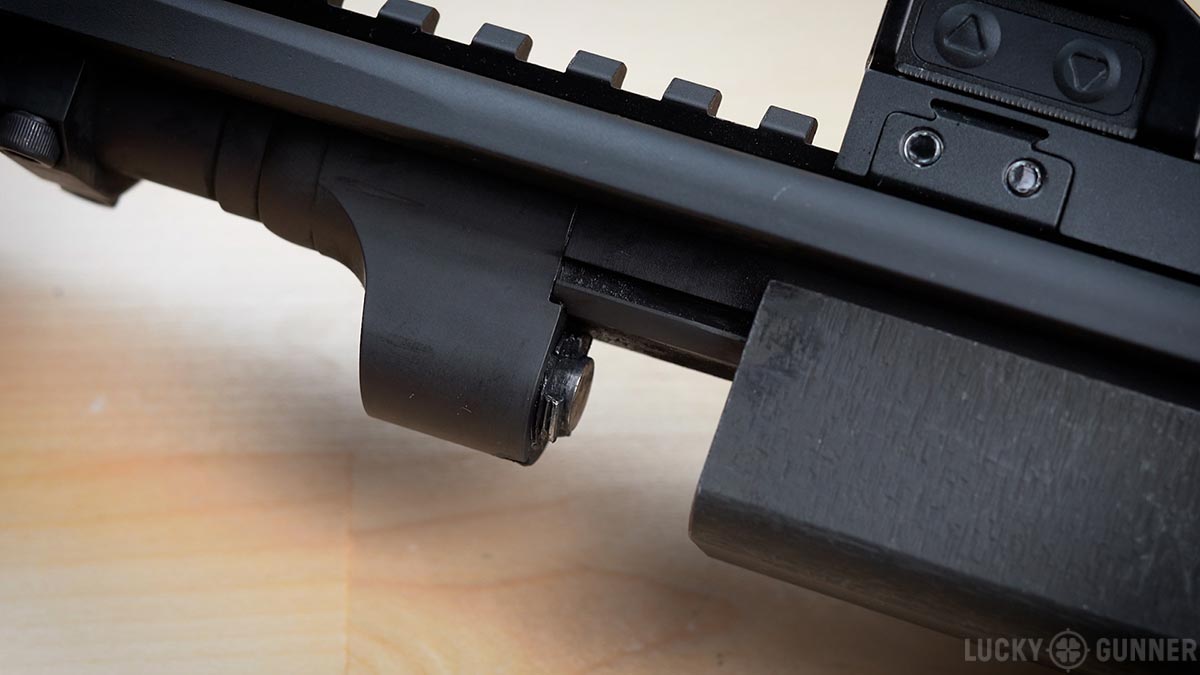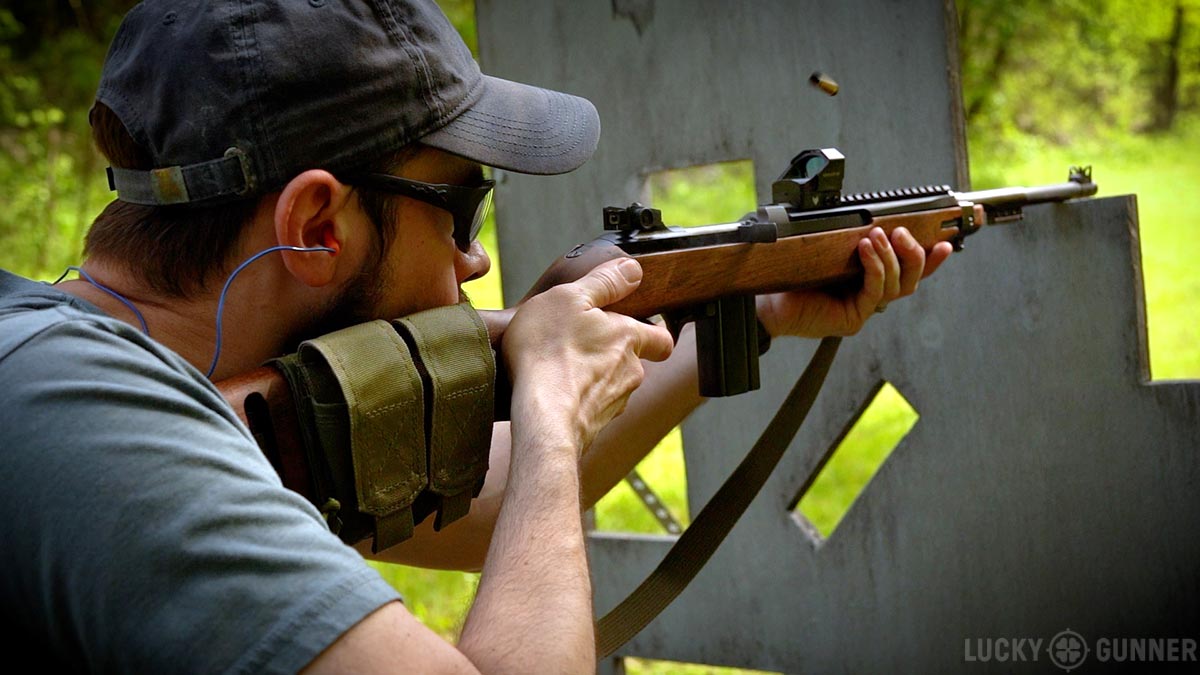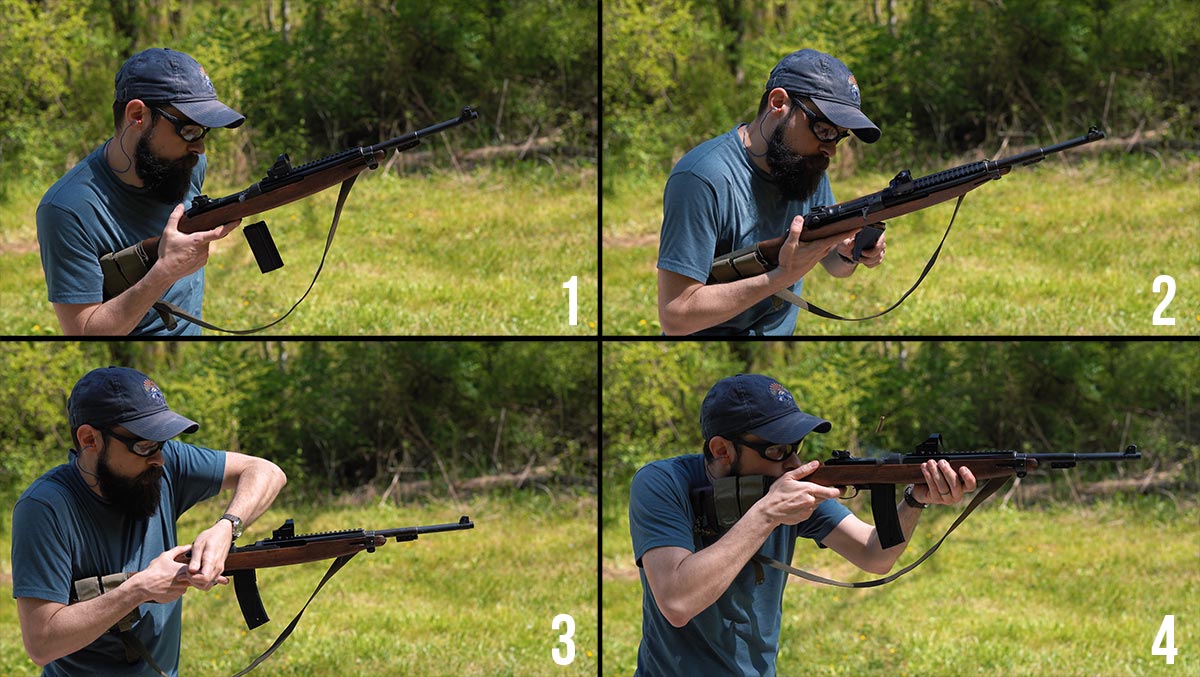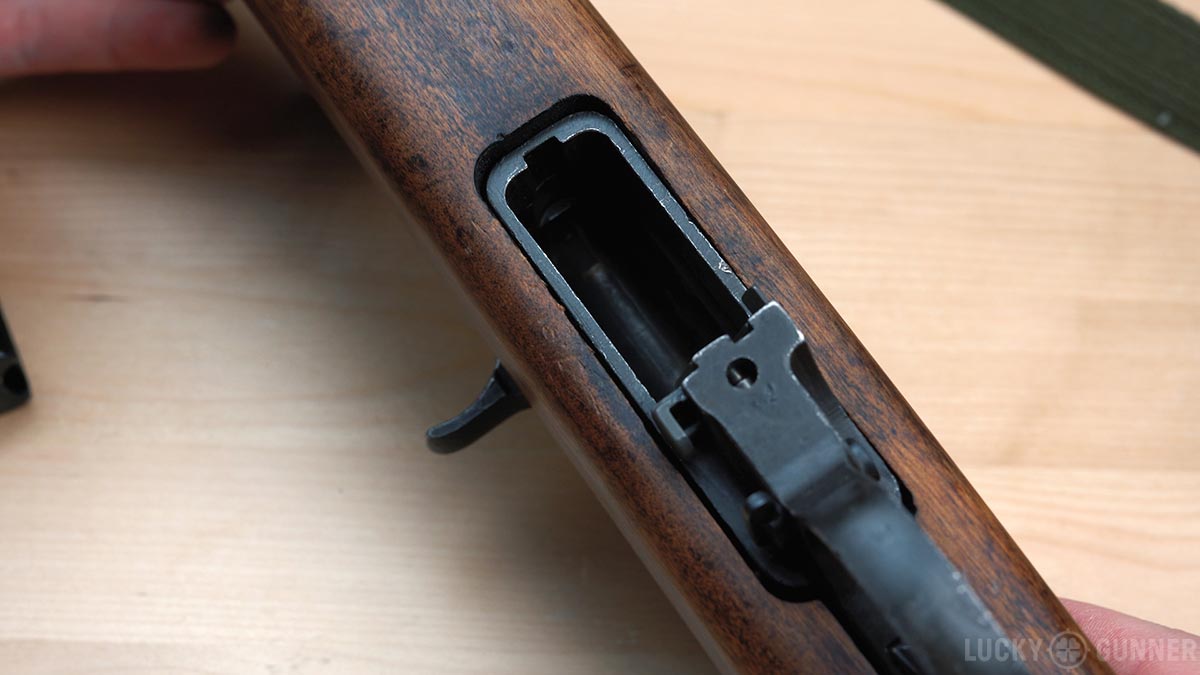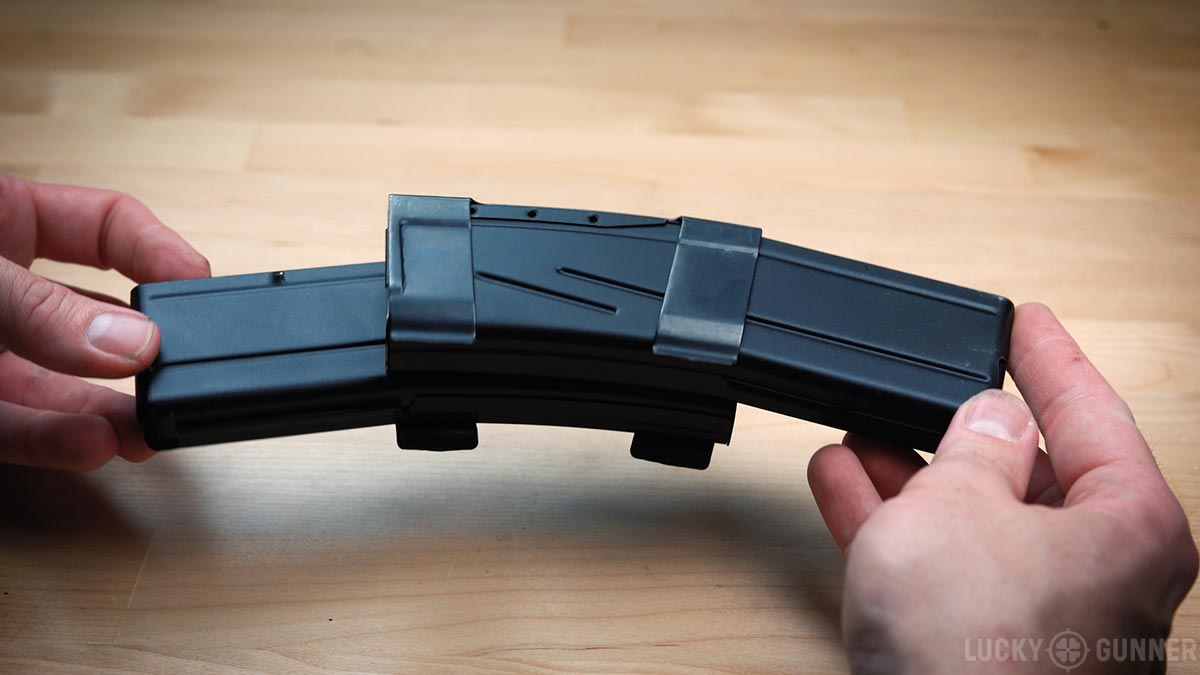Because you didn’t get enough of the M1 Carbine in our four-part series back in 2019, we’re back with more! Find out how Chris rescued a sad, mistreated carbine just so he could practice a bunch of gratuitous reloading drills. Also: the worst accessory ever made for the M1 Carbine.
As always, you can find the details in the video below, or scroll down to read the full transcript.
Hey everybody, Chris Baker here from LuckyGunner.com, back with another one of those block-rockin’ beats. This, of course, is an M1 Carbine. Some of you might remember that I did a little four-part series on the M1 Carbine back in late 2019. It is still one of my favorite guns in the world and I’ve got more to say about it. So we’re doing one more video on this rifle.
I’m going to share a few observations and lessons I’ve learned from working with this particular M1 Carbine. This was kind of a rescue project, so I’ll talk about what I had to do to get this gun up and running. Then we’ll look at some lessons relating to magazines and reloading techniques. And lastly, I will tell you what I think is the absolute worst accessory you can buy for the M1 Carbine.
A Rescue Operation
To start off, let’s look at the rifle itself. I bought this one shortly after I made that M1 Carbine series. I also picked up a couple of cases of ammo before they all disappeared. It probably goes without saying, but I’m a shooter, not a collector. I really don’t care who made what part on the rifle or if it’s original or if it’s got matching serial numbers or any of that stuff. I just want the rifle to work.
In general, the original M1 Carbines made during World War II are considered the most reliable. Several companies have produced them commercially over the years. Some of them are okay, but those guns rarely have the kind of reliability you can get out of a well-maintained GI carbine.
The one exception is Fulton Armory. The consensus seems to be that they make excellent carbines that are about as close as you can get to the original except without decades of wear and tear. They will also sell you a brand new stripped M1 Carbine receiver so you can put together your own gun from parts. That is what the original owner of this M1 Carbine did. Unfortunately, he didn’t do a very good job.
So when I got this gun, it was basically a perfect Fulton Armory receiver with a bunch of questionable parts stuck to it. The barrel was worn out. The rear sight assembly was damaged. Both were installed incorrectly. It was just kind of a mess.
So I bought a bunch of new parts and took it to a local gunsmith. They replaced everything and found a couple of other small issues I missed. I also refinished the stock and, because I’m a shameless heretic, I installed the Ultimak optic rail and a Swamp Fox Optics Justice red dot sight.
Chasing Reliability Gremilins
On my first trip to the range, the gun was having some feeding problems here and there. It turns out my gunsmith forgot to tighten the gas piston nut. That’s this little thing under the barrel. rather than drive back across town just to have him fix that, I ordered the special wrench you need to tighten the nut. Be sure to check your piston and piston nut if your carbine has reliability issues.
After I took care of that, the gun started running really well most of the time. The one remaining issue was that the last round in the magazine would frequently get stuck on the feed ramp, especially with soft point ammo. I figured the main suspect was the magazines. All of my mags were the inexpensive but generally pretty decent KCI brand magazines. So I bought an original unused and un-issued 15-round GI magazine. Those are supposed to be the most reliable magazines for this gun. With that magazine, everything fed just fine, including the soft point ammo.
Eventually, I figured out that I could put original GI followers in my KCI magazines and they would work just as well. Those followers are only five bucks a piece, so that put me at $17 total for each reliable KCI mag. That’s a pretty good deal compared to the original GI mags at about $50 each.
Now, the drawback of replacing all the followers in my KCI mags is that I lose the bolt hold-open feature. If you’re not familiar with the M1 Carbine, it does not automatically lock open when it’s empty. But there is a workaround for that. The 30-round mags, which didn’t appear until close to the end of the war, have a modified follower with a little shelf in the back. After the last round is fired, the bolt catches on the shelf and holds it open. When you remove the mag, the bolt closes again.
KCI uses the hold-open followers in their 30-round mags and in their 15-round mags. The GI followers I bought to replace the KCI followers are the standard original style that do not hold the bolt open.
A lot of shooters assume that the bolt hold open mags are superior because you get a clear indicator that the gun is empty and, in theory, it should speed up the reload. Does that really matter? Well, I’m not planning to take an M1 Carbine into combat, so probably not. Did I do a bunch of testing at the range anyway just to find out if it was actually faster? Of course I did.
M1 Carbine Magazine Testing
The only way to make this a fair and realistic test was to load an unknown number of rounds in each magazine. Ideally, the mags with the hold-open followers would give me a tactile and visual signal that the gun is empty and it’s time to reload. With the mags that had the standard GI followers, I wouldn’t know the gun’s empty until I pulled the trigger and got a click.
So I had somebody else randomly load two to five rounds in each mag without me watching. I put some steel up about 15 yards away. On the beep, I fired until the gun was empty, then performed an emergency reload from a 30-round mag in my back pocket and fired one more shot to stop the timer.
The reloading technique I’m using here is not necessarily the best or the fastest for this gun. Once you get the fresh mag inserted, there are a few different ways to get a round chambered. You can reach over the receiver with the support hand like I did. You can also go under the receiver. Or you could use your dominant hand to run the charging handle.
The way you start the reload kind of depends on whether or not the magazine drops free. The downside of the hold-open magazines is that they don’t drop free when you press the mag release. The pressure from the bolt on the follower keeps them in place. You have to hold down the mag release and pull them out. So with the hold-open mag, I would pull the empty mag and drop it before I reached for the new mag. My best times with that technique were around 4.3 seconds.
The mags with the standard follower should drop free when you press the mag release. But that doesn’t always happen, it just depends on the magazine. So first, I tried the reload several times with a mag that refused to drop free. My technique there was essentially identical to what I did with the hold-open mag. The fastest I could do it was more or less the same as before: around 4.3 seconds.
So it turns out the hold-open feature didn’t really make the reload faster. This was not what I expected to happen at all, but it makes sense now. When you fire something like an AR, the bolt carrier group has quite a bit of mass. The recoil itself is mild, but you can feel that bolt going back and forth. You don’t have to spend a ton of time behind an AR before you learn to notice when the bolt locks open. When that bolt doesn’t close after a shot, it feels different. You can usually tell.
Compared to an AR, the M1 Carbine’s bolt is very light. To me, the feel of the bolt locking open wasn’t as noticeable. Most of the time, I didn’t notice the gun was empty until the trigger went dead. That caused the slightest delay when I was doing my reloads. With the standard mags, on the other hand, pulling the trigger and getting that click is a pretty unmistakable cue that it’s time to reload.
Finally, I tried the reloading drill with a non-hold-open magazine that did reliably drop free. That allowed me to use a more efficient reloading technique. I could reach for the fresh mag at the same time I was dropping the old mag. My best times there were right around 3.5 seconds — a noticeable improvement over the other two.
So, you might think the big takeaway here is that the magazines with the standard followers that drop free are potentially faster and therefore superior to the hold-open magazines. I don’t know if I’d say that. There is definitely a case to be made for using magazines that tell you you’re holding an empty gun. I think the real takeaway from this exercise is that doing emergency reloads with the M1 Carbine is slow and annoying. The reload times I mentioned were out of my best times. If I averaged all the times, it would be more like five to five and a half seconds.
The M1 Carbine’s mag well has zero bevel. The mag release is pretty stiff, especially if you don’t hit it at just the right angle. Sometimes my finger confused the safety for the mag release. The controls are actually very good overall compared to other guns from the WWII era. But it’s nowhere near as easy as running a modern AR. Things tend to just not go as smoothly.
The Worst M1 Carbine Accessory
Now, as promised: the worst accessory available for the M1 Carbine. One of the many fun parts of owning an M1 Carbine is the wide availability of affordable parts and accessories. For example, stripper clips are cheap and super convenient. And I got a cool surplus magazine belt pouch for about 20 bucks. But not every accessory is that useful.
Behold: the jungle clip. I don’t know whether these were an original GI item or a commercial invention. Basically, it’s a magazine coupler to attach two 30-round mags together.
I know that coupling mags in the field was definitely something soldiers did with the M1 Carbine. I’ve seen pictures of it. But in those photos, the soldiers always have mags attached with tape.
The jungle clips have little protrusions that lock into the holes in the bottom of the 30-round mags. I was going to do some reloads with the jungle clips to see how much faster they would be than reloading from a pocket or pouch.
But I discovered a little flaw pretty much right away. Recoil makes the spare mag fall out of the clip. So unless I’m just really misunderstanding how these are supposed to work, I think you’d need some tape to reinforce them, or they’re basically useless. And if you’re going to do that, why not just tape the mags without the clip?
That’s not to mention that hanging two 30-round mags off the gun kind of ruins the handiness the M1 Carbine is known for. That’s an extra pound and a half on the rifle versus just 9 and a half ounces for a loaded 15-round mag. But again, I’m not running into combat with one of these things, so I’m not in any place to criticize the usefulness of coupling mags in general. But I do question the viability of this particular method of doing it.
There is even more I could say about the M1 Carbine, but you guys have probably had enough for today. I’m still collecting questions for our next Q&A video. You can always ask those in the comments, but if you really want to make sure I see them, send an email through our contact form. Until next time, stay safe and don’t forget to floss.
The post The M1 Carbine Revisited appeared first on Lucky Gunner Lounge.




